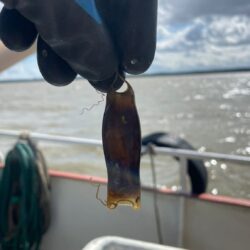As we head into summer you may be spending more time enjoying the beaches across the UK, if so, it is important to draw your attention to these objects pictured below – an elasmobranch egg case commonly known as a mermaid’s purse. These are produced by some species of sharks, rays, and skates and are responsible for protecting the embryo during its development. Once the shark, skate, or ray has emerged, the empty egg cases often wash up on the beach.
It is important to note not all sharks, skates and rays produce eggs, many also give birth to live young. Some UK species which do produce egg cases include, the small spotted catshark (Scyliorhinus canicula), nursehound catshark (Scyliorhinus stellaris), blackmouth catshark (Galeus melastomus), thornback ray (Raja clavata), small-eyed ray (Raja microocellata), blonde ray (Raja brachyura), starry skate (Amblyraja radiata), flapper skate (Dipturus intermedius), and blue skate (Dipturus batis), as well as many others.
One of the most common of these species in the UK is the Thornback ray, which can be found in locations such as the Thames Estuary, the Wash, the Solent, Carmarthen Bay, Cardigan Bay, Liverpool Bay and the Solway Firth. These rays can grow up to 1m in length and are described as short-snouted, typically diamond shaped, and with colours that vary from mottled brown to grey with several small dark spots and yellowish patches. On top of their body, they have a row of 30-50 spines/thorns that run from back of the head down towards their tail, hence their common name. They can be found on a variety of bottom types, such as mud, sand, shingle and gravel, as deep as 300 metres, however they are most commonly detected between 10 and 60 metres.
Thornback rays can lay up to 150 egg cases a year, and they are mostly made of keratin which make the capsules strong and flexible. In order to differentiate mermaid’s purses from different species there are different distinguishable features to look out for. For example, an egg case from the Thornback ray has a narrow ridge running along the edge of the capsule, whereas a different species, such as the spotted ray lacks this feature. In addition, eggs laid by rays and skates generally have two horns or spikes on either end of the capsule, these are used to anchor the egg case into the soft seafloor of a nursery habitat. However, those produced by sharks more likely have tendrils, like curly string, that is used to wrap around seaweed fronds to secure the egg capsule.
Egg cases can come in all shapes and sizes and can be difficult to identify. The Sharks Trust provides a great identification guide through their app, so you can easily access it on the go this summer! You can also report your sightings through the app to contribute to the database on the presence and diversity of species in our waters. For more information see: https://www.sharktrust.org/geh-search.
